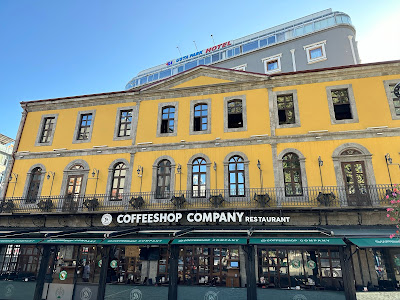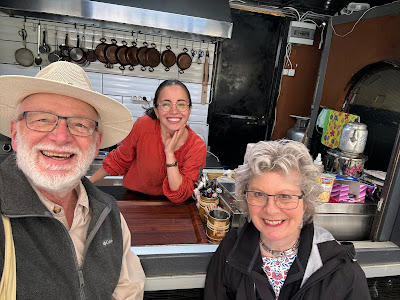 |
| Trabzon’s Meydan or central square |
For tourists from Iran and Iraq, it’s a road trip. For visitors from Saudi Arabia or Dubai, it’s a weekend get-away via a non-stop flight on a discount airline. For us, a visit to the Black Sea coastal city of Trabzon, is a chance to immerse ourselves in a part of Turkey well-known to Middle-Eastern travelers but off -the -radar for most European and Americans whose itineraries rarely take them this far east, almost to the border with Georgia.
Walking through the bazaar quarter our first morning, passing shops selling fresh bread, handmade brooms, socks and cooper pots, we stop to buy a simit, one of the sesame-covered dough rings sold on every corner. A woman gives me the thumbs up, and asks where we are from. “America,” I tell her. “America!” she repeats, then touches my arm. “Welcome.”
 |
| Dress is conservative, but fashionable |
 |
| Morning bakery stop |
For anyone who has heard the stories about locals in Barcelona, Venice or Amsterdam shunning tourists, it’s a great feeling to go to a corner of the world not used to seeing Western visitors. Little English is spoken, but everyone goes out of their way to communicate, often with hand signals, a calculator, a smile or a warm gesture. Trabzon is an ancient city, historically important due to its location along the Silk Road, the trading route between Europe and Asia. Cruise ships call at a port that serves as a gateway to Iran, Iraq, Azerbaijan, Armenia, Uzbekistan and Turkmenistan. The main tourist draw is the Sumela Monastery, built into a mountain cliff 4,000 feet above sea level by Greek monks in the 4th century. I'll get to that later, but for now, we're enjoying the walkable and mostly-pedestrianized city center with its tea gardens, parks and inexpensive restaurants and cafes.
 |
| Hand-made brooms for sale in the bazaar |
Local life centers around the Meyden, a large square lined with benches, lights and trees where people gather all day and night. The centerpiece is a statue of Mustafa Ataturk who founded Turkey as a democratic republic in 1923, and is credited with modernizing it as a secular nation after Ottoman rule.
Surrounding the square are restaurants and cafes in historical buildings. The one below, built almost entirely out of stone, houses a Viennese coffee shop where you can order a latte, smoke a water pipe, or sip a tiny glass of locally-grown black tea. We found one pub on the square that serves alcohol, but most places don‘t. Trabzon was originally Christian and Greek Orthodox until it was captured by the Ottoman Turks in 1461. Today's it is mostly Muslim. While Turkish women wear either colorful head scarves or choose not to cover at all, here it's common to see Saudi and Iranian visitors walking the streets in white sneakers hidden under full-length black chadors.
Trabzon was a major copper mining center during the Ottoman era, and the craft still flourishes. The bazaar quarter is lined with shops selling copper pans and kitchen ware, although from what we saw in shop windows, it seems like more modern materials such as Teflon and Aluminum are catching on with today’s cooks.
 |
| Copper kitchenware for sale |
Other specialties include hefty rounds of sourdough bread baked in stone ovens and rice pudding made with cows milk from the mountain villages in the high-plateau area of Hamiskoy.  |
| Vakfukebir for sale in the bazaar |
The cows feed on wild flowers that impart a unique flavor to the milk which is then boiled for three hours. The pudding is sold everywhere in pottery crocks for about $3. We had our first of many helpings at a shop called Ugar Usta Hamiskoy Sutlaci Ayasofa, which served it either plain or with honey or ice cream.  |
| Our first of many servings of Hamiskoy sutlaci |
 |
The milk for Trabzon’s rice pudding comes from the highland mountain villages of Hamiskoy, a farming area above Trabzon
|
Trabzon residents are very proud of their city's reputation as a cultural capital of the Black Sea coast. It seems like every other shop is a pastry shop specializing in desserts made with pistachio nuts. This dessert resembles a pie-shaped piece of baklava filled with pistachio.
 |
| Tom enjoying Kuymak |
Kuymak is a Turkish breakfast dish that looks like a Swiss cheese fondue. It's made with cheese and corn meal, and eaten with bread and a wooden spoon.
 |
| Aya Sofia |
Trabzon doesn’t have many historic sites, but one is the Aya Sofia, built as a Greek Orthodox Church in 1238, and converted into a mosque following the conquest of Trabzon by the Ottomans in the 1400s.  |
| Sumela Monastery |
Cruise ships call in Trabzon mainly so passengers can take a day trip into the mountains to tour the Sumela Monastery. We went in a small van excursion booked through Get Your Guide. I took us about 45 minutes to climb on the winding roads into the mountains where two Greek priests built a cave church in the 4th century to honor the Virgin Mary. The path into the monastery has been much improved with boardwalks and stone steps compared to a few years ago when visitors had to navigate root-strewn trails. Still, it was quite a climb. Our tour brochure said “not suitable or those over 95,” so we figured we qualified.


 |
|
This was the most important of many monasteries built during the Byzantine era and the best preserved, even after it was abandoned in 1923 when the Turkish Republic was created. It’s believed that 150 monks lived here over the years. Rooms were designated as the kitchen, dining area and library as well as various chapels, some containing 9th century frescos restored to erase scratches and traces of vandalism.
 |
| Hidirnebi Yala |
When Turks and visitors from hot climates want to escape the heat, they head for the yaylas, mountain farming villages above the tree line. The closest yayla to Trabzon is Hidirnebi where Saudi, Iranians, Syrians and others have bought summer homes or vacation villas. Some live close enough to drive. Others fly.
We visited here on another Get Your Guide day trip which also included a stop at Cal Cave, one of many accessible caves in the area. The scenery is beautiful, but often obscured by fog. As our driver navigated steep hair pin turns, we could see almost nothing. We wondered what we would do here for the two hours time allotted. Then the fog cleared, and the afternoon unfolded.
 |
| Cafe Çimen |
Fall is a slower time there, and there were few people around. Summers are busier when families rent tents for the day, try zip-lining, ride horses and picnic in makeshift outdoor living rooms set up by the local restaurants. We shopped around for a place to have tea before settling on the Cafe Cimen where the owner positioned little tables on the hillside and pillows on the ground for picnics.
We ordered tea and rice pudding, then talked a while with Burcu, the cafe owner’s wife, an English teacher in the nearby high school. She said we were the first Americans she had ever seen in the village. She was as thrilled as we were to carry on a conversation in English.
 |
| Burcu and her special gozleme. |
She insisted we sample her special gozleme a Turkish flatbread stuffed with sweet peppers and white cheese.  |
| Table with a view |
"The world is so small," she said in a WhatsApp message after we exchanged pictures to share with her students. It's always impromptu encounters like this that produce the best travel memories.






















Fun as always to travel along virtually with your exciting adventures in exotic places
ReplyDeleteWhat a great trip! Now I want to visit this area. Great photos to go with the story!
ReplyDeleteThe old name of Trabzon was Trebizond - for a look back, try "The Towers of Trebizond" by Rose Macaulay
ReplyDeleteWonderful pictures and information. Didn't know about this part of Turkey...intriguing...makes me want to visit!!
ReplyDelete